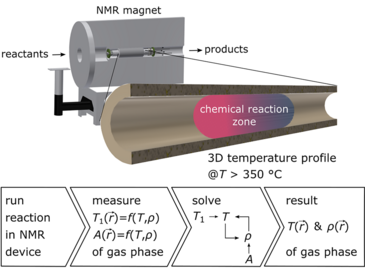Harm Ridder, Christoph Sinn, Georg R. Pesch, Wolfgang Dreher, Jorg Thöming
Chemical Engineering Journal 433 (2022), 133583
https://doi.org/10.1016/j.cej.2021.133583
In the last decade, in-situ studies using nuclear magnetic resonance (NMR) showed the possibility to monitor local transport phenomena of gas-phase reactions inside opaque structures. While spatial species concentration is known to be accessible operando during heterogeneously catalyzed gas-phase reactions, the spatial acquisition of gas temperatures has proven to be challenging. So far, temperature information is gathered by auxiliary liquid-filled capillaries with temperature-dependent NMR-properties. Here, we present a method for spatially resolved temperature and density measurements of gases using the temperature dependence of the signal amplitude and the longitudinal relaxation time (T1). In order to support the proposed method, temperature measurements of methane-filled tubes are carried out and compared to state-of-the-art temperature measurements using glycerol-filled capillaries. To demonstrate the applicability of the method during heterogeneously catalyzed gas-phase reactions, we measured the temperature operando inside a catalytically active honeycomb structure at standard pressure. The results show that direct temperature measurements of gases are possible, even though the low pressure inside the methane-filled tubes led to a low signal-to-noise ratio which compromised the accuracy of the data yielding relative errors of up to 7 %. This study focusses on temperature measurements of pure methane only. When applied to mixtures of gases, however, the proposed method has the potential to measure gas temperature and concentration at the same time.
© The Authors, https://doi.org/10.1016/j.cej.2021.133583, licensed under CC BY 4.0


